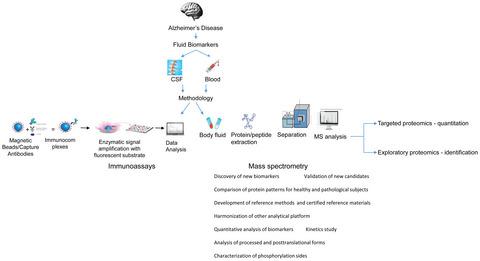当前位置:
X-MOL 学术
›
J. Neurochem.
›
论文详情
Our official English website, www.x-mol.net, welcomes your
feedback! (Note: you will need to create a separate account there.)
Mass spectrometry-based methods for robust measurement of Alzheimer's disease biomarkers in biological fluids
Journal of Neurochemistry ( IF 4.2 ) Pub Date : 2021-07-10 , DOI: 10.1111/jnc.15465 Magdalena Korecka 1 , Leslie M Shaw 1
Journal of Neurochemistry ( IF 4.2 ) Pub Date : 2021-07-10 , DOI: 10.1111/jnc.15465 Magdalena Korecka 1 , Leslie M Shaw 1
Affiliation

|
Alzheimer's disease (AD) is the most common form of dementia affecting 60%–70% of people afflicted with this disease. Accurate antemortem diagnosis is urgently needed for early detection of AD to enable reliable estimation of prognosis, intervention, and monitoring of the disease. The National Institute on Aging/Alzheimer's Association sponsored the ‘Research Framework: towards a biological definition of AD’, which recommends using different biomarkers in living persons for a biomarker-based definition of AD regardless of clinical status. Fluid biomarkers represent one of key groups of them. Since cerebrospinal fluid (CSF) is in direct contact with brain and many proteins present in the brain can be detected in CSF, this fluid has been regarded as the best biofluid in which to measure AD biomarkers. Recently, technological advancements in protein detection made possible the effective study of plasma AD biomarkers despite their significantly lower concentrations versus to that in CSF. This and other challenges that face plasma-based biomarker measurements can be overcome by using mass spectrometry. In this review, we discuss AD biomarkers which can be reliably measured in CSF and plasma using targeted mass spectrometry coupled to liquid chromatography (LC/MS/MS). We describe progress in LC/MS/MS methods’ development, emphasize the challenges, and summarize major findings. We also highlight the role of mass spectrometry and progress made in the process of global standardization of the measurement of Aβ42/Aβ40. Finally, we briefly describe exploratory proteomics which seek to identify new biomarkers that can contribute to detection of co-pathological processes that are common in sporadic AD.
中文翻译:

用于稳健测量生物体液中阿尔茨海默病生物标志物的基于质谱的方法
阿尔茨海默病 (AD) 是最常见的痴呆形式,影响 60%–70% 的患有这种疾病的人。AD 的早期检测迫切需要准确的生前诊断,以便可靠地估计疾病的预后、干预和监测。国家老龄化研究所/阿尔茨海默氏症协会赞助了“研究框架:对 AD 的生物学定义”,该框架建议在活人中使用不同的生物标志物来确定基于生物标志物的 AD 定义,而不管临床状态如何。流体生物标志物代表其中的关键组之一。由于脑脊液 (CSF) 与大脑直接接触,并且可以在 CSF 中检测到存在于大脑中的许多蛋白质,因此这种液体被认为是测量 AD 生物标志物的最佳生物流体。最近,蛋白质检测的技术进步使有效研究血浆 AD 生物标志物成为可能,尽管它们的浓度明显低于 CSF 中的浓度。使用质谱可以克服基于血浆的生物标志物测量所面临的这一挑战和其他挑战。在这篇综述中,我们讨论了可以使用靶向质谱联用液相色谱 (LC/MS/MS) 在脑脊液和血浆中可靠测量的 AD 生物标志物。我们描述了 LC/MS/MS 方法开发的进展,强调了挑战,并总结了主要发现。我们还强调了质谱的作用以及在 Aβ42/Aβ40 测量的全球标准化过程中取得的进展。最后,
更新日期:2021-07-10
中文翻译:

用于稳健测量生物体液中阿尔茨海默病生物标志物的基于质谱的方法
阿尔茨海默病 (AD) 是最常见的痴呆形式,影响 60%–70% 的患有这种疾病的人。AD 的早期检测迫切需要准确的生前诊断,以便可靠地估计疾病的预后、干预和监测。国家老龄化研究所/阿尔茨海默氏症协会赞助了“研究框架:对 AD 的生物学定义”,该框架建议在活人中使用不同的生物标志物来确定基于生物标志物的 AD 定义,而不管临床状态如何。流体生物标志物代表其中的关键组之一。由于脑脊液 (CSF) 与大脑直接接触,并且可以在 CSF 中检测到存在于大脑中的许多蛋白质,因此这种液体被认为是测量 AD 生物标志物的最佳生物流体。最近,蛋白质检测的技术进步使有效研究血浆 AD 生物标志物成为可能,尽管它们的浓度明显低于 CSF 中的浓度。使用质谱可以克服基于血浆的生物标志物测量所面临的这一挑战和其他挑战。在这篇综述中,我们讨论了可以使用靶向质谱联用液相色谱 (LC/MS/MS) 在脑脊液和血浆中可靠测量的 AD 生物标志物。我们描述了 LC/MS/MS 方法开发的进展,强调了挑战,并总结了主要发现。我们还强调了质谱的作用以及在 Aβ42/Aβ40 测量的全球标准化过程中取得的进展。最后,











































 京公网安备 11010802027423号
京公网安备 11010802027423号